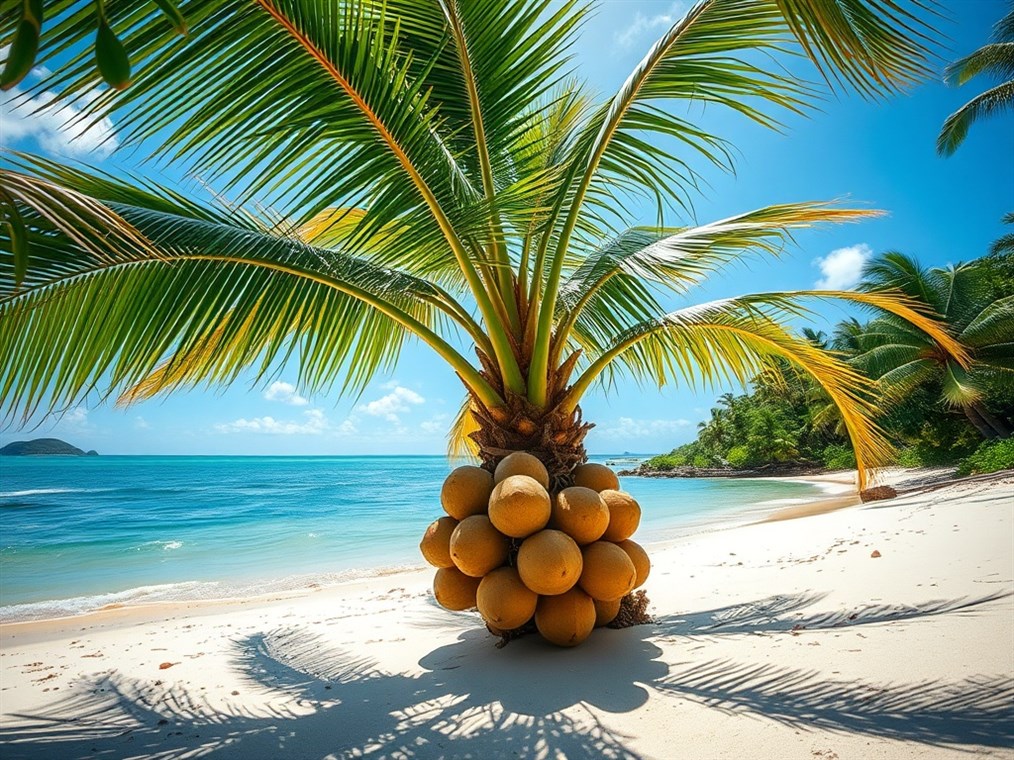The Coco de Mer: Seychelles’ Endemic Botanical Marvel
Picture this: an island paradise, the Seychelles, where nature plays by its own rules. Here, you’ll find the Coco de Mer (Lodoicea maldivica), a palm so unique it’s like something straight out of a storybook. It’s not just any tree; it’s a botanical superstar found naturally only on Praslin and Curieuse islands. What makes it so special? Well, it grows the largest and heaviest seeds on the planet. Seriously, these things are massive!
Unique Characteristics
Let’s talk records. The Coco de Mer doesn’t just break them; it shatters them. Its seeds can tip the scales at a whopping 55-66 pounds and stretch nearly a foot across. And the leaves? Forget regular palm fronds; these are like green sails, reaching over 30 feet long. Now, here’s a quirky fact: this palm is a bit like humans – it has separate male and female trees. The ladies produce those iconic, shall we say, cheeky-shaped nuts, while the fellas sport long, cylindrical catkins. Oh, and did I mention it also boasts the largest flowers of any female palm?
But here’s the kicker: patience is key with the Coco de Mer. We’re talking decades, 25 to 50 years, before it even thinks about flowering. And once it’s pollinated, you’re looking at another 6-10 years for the fruits to ripen. Talk about slow food! But hey, good things come to those who wait, right? Especially since these palms can potentially keep doing their thing for up to 800 years.
Habitat and Distribution
These palms aren’t too fussy, but they do have their preferences. They love the tropical forests of Praslin and Curieuse, especially the sunny hillsides and valleys where they can soak up the rays and get plenty of moisture. They’ve also got a thing for well-drained granitic soils. Think hot, humid, and just right. Back in the day, you could find Coco de Mer all over the Seychelles, but sadly, those days are gone. Today, they’re an endangered species. You’ll find the remaining stands tucked away in protected bio-reserves on Praslin and Curieuse, carefully watched over by the Marine Parks Authority.
Reproduction and Pollination
The birds and the bees… or rather, the palms and the… well, we’re not entirely sure. What we do know is that male and female flowers grow on separate trees. Wind is thought to play a part, carrying pollen from the boys to the girls. But some scientists suspect that insects or other critters might lend a hand too. It’s still a bit of a mystery, to be honest. And get this: a recent study suggests these palms like to keep it in the family. They seem to prefer hooking up with closely related mates, with parent trees often just a stone’s throw away from each other.
Cultural Significance and Legends
Now, this is where it gets really interesting. The Coco de Mer isn’t just a plant; it’s a legend. Before anyone even knew the Seychelles existed, these nuts would wash up on distant shores, like the Maldives. People thought they came from a mythical tree at the bottom of the ocean. Hence the name “Coco de Mer,” which is French for “coconut of the sea.”
And let’s be real, the shape of the nut has definitely sparked some imaginations. There’s this old story about how the male trees uproot themselves on stormy nights and get all romantic with the female trees. And if you happen to stumble upon this botanical rendezvous? Well, legend has it you’ll either die or go blind. Spooky, right? Today, the Coco de Mer is a national symbol of the Seychelles, proudly displayed on the country’s passport.
Uses and Conservation
So, what’s the Coco de Mer good for? Well, for starters, the Seychellois government keeps a close eye on these trees. They’re super careful about harvesting and trade to prevent things from getting out of hand, though poaching is still a worry. The nuts have been used in traditional medicine for ages, from Ayurvedic practices to traditional Chinese remedies. In India and Saudi Arabia, you might even find them used as ceremonial bowls in temples and mosques. The kernel is known for its healing and aphrodisiac properties. The hard shell of the nut has been used to make functional tools, such as scoops.
Sadly, the Coco de Mer is on the endangered list. There are only around 8,200 of them left, and the population has dropped by about 30% in recent years. Forest fires, illegal harvesting, invasive species, and climate change are all taking their toll.
But it’s not all doom and gloom. There are people working hard to protect these amazing palms. The Seychelles government has strict rules about harvesting and exporting the seeds, and scientists are trying to learn more about how they grow and how we can help them. Organizations like the Seychelles Islands Foundation are also studying how these palms get pollinated.
Coco de Mer Hotel
If you fancy seeing these incredible palms up close, why not check out the Coco de Mer Hotel & Black Parrot Suites on Praslin Island? It’s nestled in beautiful tropical gardens and offers stunning views of the ocean.
The Coco de Mer is more than just a plant; it’s a symbol of the Seychelles and a reminder of the wonders of nature. It’s up to all of us to help protect it for future generations.

